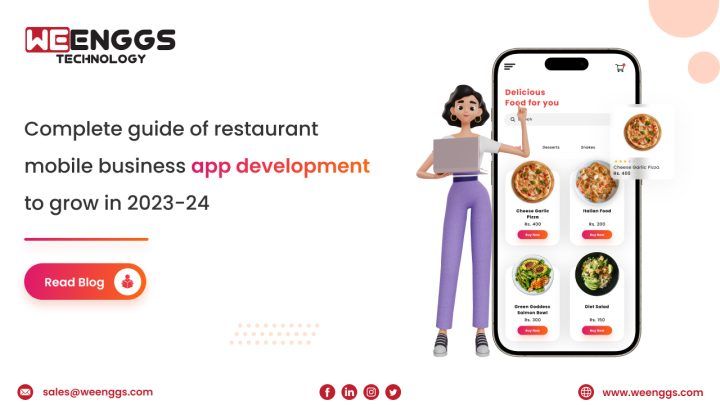The restaurant industry has undergone a significant transformation in recent years, with mobile technology playing a pivotal role in shaping the way customers interact with food establishments.
To stay competitive and meet customer expectations in 2023-24, restaurants need to invest in the development of a robust mobile app. This guide will walk you through the essential steps and strategies for creating a successful restaurant mobile app.
Why Does Your Restaurant Need a Mobile App?
Before diving into the development process, it’s crucial to understand why having a mobile app is essential for your restaurant’s growth:
- Enhanced Customer Experience: A well-designed app offers a seamless and convenient way for customers to browse menus, make reservations, and place orders.
- Improved Customer Loyalty: Loyalty programs, personalized offers, and push notifications can encourage repeat visits and increase customer retention.
- Increased Revenue: Mobile apps can drive more orders and table bookings, leading to higher revenue generation.
- Competitive Advantage: Having an app sets you apart from competitors who rely solely on traditional dine-in services.
- Data Insights: Mobile apps collect valuable customer data that can be used to refine marketing strategies and menu offerings.
Now that you understand the importance of a restaurant mobile app, let’s delve into the development process.
Step 1: Define Your Objectives
Before you start building your app, outline your specific goals and objectives. Consider what you want to achieve with the app, such as increasing online orders, boosting table reservations, or improving customer engagement.
Step 2: Choose the Right Development Approach
There are two primary development approaches for restaurant apps:
- Native Apps: These are developed for a specific operating system, such as iOS (using Swift) or Android (using Java or Kotlin). Native apps offer high performance and access to device-specific features but require separate development for each platform.
- Cross-Platform Apps: These apps are built using frameworks like React Native or Flutter, allowing you to write code once and deploy it on multiple platforms. While they may not offer as high performance as native apps, they are cost-effective and save development time.
The choice between native and cross-platform development depends on your budget and timeline.
Step 3: Features and Functionality
Decide on the features and functionality your restaurant app will offer. Here are some essential features to consider:
- Menu and Ordering:
Allow customers to browse the menu, customize orders, and place them directly through the app. - Table Reservations:
Enable customers to book tables for dine-in. - Online Payment:
Integrate secure payment gateways for online orders. - Push Notifications:
Send personalized promotions, updates, and order confirmations. - Loyalty Program:
Implement a loyalty program with rewards and discounts for repeat customers. - User Reviews and Ratings:
Let customers leave reviews and ratings for your restaurant. - Social Media Integration:
Allow users to share their dining experiences on social platforms.
Step 4: Design and User Experience
The design of your app plays a significant role in user engagement. Ensure that your app has an intuitive and visually appealing interface. Pay attention to factors like color schemes, typography, and navigation. Conduct usability testing to refine the user experience.
Step 5: Development and Testing
Work with experienced app developers to bring your vision to life. Regularly test the app for bugs and glitches to ensure a smooth user experience. Beta testing with a small group of users can help identify issues before the official launch.
Step 6: Integration and Security
Integrate the app with your restaurant’s backend systems, including the POS (Point of Sale) system and inventory management. Ensure that customer data is securely stored and encrypted to protect their privacy.
Step 7: Marketing and Promotion
Launching the app is just the beginning. To drive downloads and usage, create a marketing strategy. Utilize social media, email marketing, and in-house promotions to encourage customers to download and use the app.
Step 8: Gather and Analyze Data
Collect and analyze data from the app to gain insights into customer behavior. This data can inform menu changes, marketing strategies, and improvements to the app itself.
Step 9: Gather Customer Feedback
Encourage customers to provide feedback on their app experience. Use this feedback to make continuous improvements and address any issues.
Step 10: Regular Updates
Keep your app up to date with the latest features, security patches, and bug fixes. Regular updates demonstrate your commitment to providing a high-quality experience.
A well-designed restaurant mobile app can be a game-changer for your business in 2023-24. It enhances the customer experience, drives revenue, and keeps you competitive in a rapidly evolving industry. By following the steps outlined in this guide, you can develop a successful restaurant mobile app that contributes to your growth and success in the years to come.
Weenggs Technology has an expert team of iOS app developers who can help you with the best and affordable solution for your business. Talk to us at sales@weenggs.com


